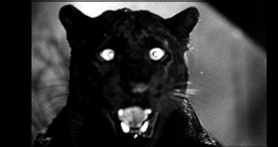Fri 22 Sep 2023
A Movie Review by Mike Tooney: THE LEOPARD MAN (1943).
Posted by Steve under Reviews , Suspense & espionage films[3] Comments

THE LEOPARD MAN. RKO, 1943. Cast: Dennis O’Keefe, Margo, Jean Brooks, Isabell Jewell, Marguerite Silva, Abner Biberman, James Bell, Margaret Landry, Fely Franquelli, Ariel Heath, Tuulikki Paananen. Producer: Val Lewton. Writers: Ardel Wray and Edward Dein, based on the novel Black Alibi (1942) by Cornell Woolrich. Director: Jacques Tourneur.

Despite what everybody says about The Leopard Man, it’s not really a horror film. Of course it looks and even sounds like one most of the time, and it’s true producer Val Lewton specialized in horror films (e.g., Cat People, I Walked with a Zombie, etc.). Nevertheless, when you eliminate all the terror trappings, what’s left isn’t just a crime movie but an actual mystery film.
It’s clear the intention was to ratchet up the suspense as much as possible — and then go beyond that. So it’s surprising to realize that just about every moment of violence is off screen; lighting and sound effects do the job of suggesting the horrors we don’t see.

When someone is attacked and murdered on one side of a door, we and another person on this side of it hear the violent scuffle but only see the victim’s blood oozing under the door.
In a darkened cemetery dimly lit by a hazy moon, another victim is stalked by something unseen up in the trees. The camera focuses on the tree limbs as they creak downward and then spring up, with the attacker just out of visual range. All we hear is a muffled scream.
The Leopard Man has many moments like that. The source material was Black Alibi, a 1942 novel by Cornell Woolrich.
****
Numerous books and stories by Cornell Woolrich have been adapted for other media, such as these films: ‘Convicted’ (1938), ‘Street of Chance’ (1942), ‘Phantom Lady’ (1944), ‘The Mark of the Whistler’ (1944), ‘Deadline at Dawn’ (1946), ‘Black Angel’ (1946), ‘The Chase’ (1946), ‘Fall Guy’ (1947), ‘The Guilty’ (1947), ‘Fear in the Night’ (1947), ‘The Return of the Whistler’ (1948), ‘I Wouldn’t Be in Your Shoes’ (1948), ‘Night Has a Thousand Eyes’ (1948), ‘The Window (1949), ‘No Man of Her Own’ (1950), 6 episodes of the ‘Suspense’ TV series (1949-50), 3 segments of ‘Robert Montgomery Presents’ (1950-51), ‘Rear Window’ (1954), ‘Obsession’ (1954), ‘Nightmare’ (1956); 3 installments each of ‘Lux Video Theatre’ (1954-57), ‘The Ford Television Theatre’ (1955-57), ‘Alfred Hitchcock Presents’ (1956-58), and ‘Thriller’ (1961); ‘The Bride Wore Black’ (1968), ‘You’ll Never See Me Again’ (1973, TVM), even ‘Mrs. Winterbourne’ (1996) — and this list of media adaptations is hardly exhaustive.
September 23rd, 2023 at 6:10 am
Lewton/Tourneur – one of the great producer/director combinations and, as you say, they frighten you with what you don’t see. I wonder just how much Lewton had to do with the actual making of his films.
September 23rd, 2023 at 7:31 am
I really enjoyed the way the writers, director, and producer forged a stylistic link between the incidents so loosely connected in Woolrich’s novel.
September 23rd, 2023 at 9:38 pm
The book is more of a thriller, but the movie has actual detective moments as they realize the cat isn’t the only killer running loose.
There is more dread than violence in the Lewton films, horrors suggested and not shown. CURSE OF THE CAT PEOPLE isn’t horror either, part ghost story and child’s fantasy. THE BODY SNATCHERS is one of the few with actual horror shown in it when Lugosi’s corpse attacks Karloff.